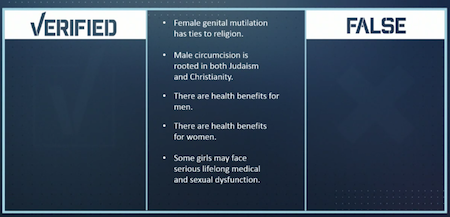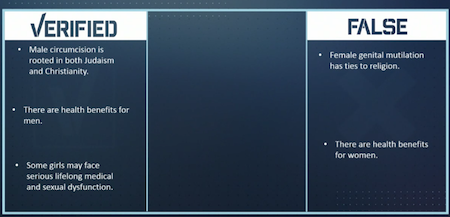tl;dr version:
Dr. Berman writes:
… Thankfully, [male circumcision] is a choice that we do have here in America, unlike the millions of young girls across the globe who must endure genital mutilation with no option to decline.
Her analysis shifts depending on whether a male or female is cut without need or consent. Male circumcision is “a choice that we do have here in Americaâ€. “Thankfully”¹. Her male circumcision argument is about parents, without consideration for the child. She then compares the victims of FGM “who must endure genital mutilation with no option to decline.†When did I have the option to decline my mutilation? When did any boy circumcised without need have the option to decline? Her argument is sophistry. It’s garbage and shows why any defense of male circumcision as ethically different from female genital mutilation is mistaken. Dr. Berman should feel shame for even thinking that sentence.
Dr. Laura Berman posted a question on Facebook, asking:
Men, how do you feel about your circumcision (if you were circumcised)? Do you wish you weren’t, or do you think your parents made the right choice? And women – do you have a preference when it comes to partners who are circumcised vs. uncircumcised?
The replies are roughly in line with what anyone should expect from a circumcision thread. In response to some comments asking her opinion, she followed with a blog post about it, “When You Miss Your Foreskin: The Real Deal on Male Circumcision”. Early on, she writes:
First, as a Jewish woman, I want to acknowledge that there is a cultural legacy behind circumcision which informs many people in my community and their decision to circumcise. While I appreciate and love my Jewish heritage, I realize this is not enough of a reason to perform surgery on an infant without medical cause.
That statement takes courage and is worth commending. Unfortunately, she does not let that inform enough of the rest of her post. She continues:
The pediatric community is still largely in favor of circumcision, as they say that the benefits of circumcision outweigh the risks. What are these benefits?
She links the AAP’s 2012 statement there, which I’m omitting because you can get there here or here, instead. Apart from quoting the AAP’s flawed statement, quoting the AAP as “the pediatric community” is silly. The *American* pediatric community is still largely in favor of (non-therapeutic infant) circumcision. Most of the rest of the world is not in favor, for the reason Dr. Berman touches and then skips. There is not enough of a reason to perform surgery on an infant without medical cause. (There is no reason. There is no medical cause.) That’s the ethical principle applicable here, as in non-therapeutic genital surgeries on female minors. There’s no reason to exclude male circumcision from ethics.
After reviewing some potential benefits of circumcision, including the casual sexism of “for little boys who hate to bathe”, which should be rewritten as “for parents who abdicate their responsibilities”, Dr. Berman gets to some negatives. She writes:
Loss of nerve endings. Removing the foreskin also removes thousands of nerve openings that make sex more pleasurable.
It’s beyond comprehension how someone can write that fact and not end the post there with, “Yeah, this is wrong. We must stop immediately. And we should apologize for every non-therapeutic, non-consensual circumcision performed before now, because we were wrong to perform every one of them.” But she doesn’t, because of the usual consequentialism and moral relativism involved in this debate that predictably appears in her post. She continues:
… Along with physical pain, many men later report that they feel they feel violated as their circumcision was done without their consent.
Although I feel violated, that is a direct result of being violated. My non-therapeutic circumcision occurred without my consent. My circumcision violated me. I know why we avoid acknowledging this as a society, but it’s too blatant to be defensible.
Dr. Berman shifts to something worth repeating:
Last, before I end, I want to address the issue of consent around circumcision. One man on my Facebook post compared circumcision to rape, and while I appreciate his right to anger about his circumcision, we must be very, very careful when we use the word ‘rape’ to describe anything other than rape. Words matter. They are powerful. They shape our beliefs and they inform the way we live in this world. So when we use the word ‘rape’ to talk about a medical procedure performed in good faith, this does a grave injustice to rape victims who have been abused, traumatized, penetrated and dehumanized by a sexual predator(s).
I agree with this, and stand by what I’ve written on it.
However, what is consent, if not the ability to reject something you neither need nor want? It shouldn’t be discussed in the context of calling circumcision “rape”. We must discuss consent, though,
because it’s the crux of the violation. You don’t believe in consent if you believe consent in non-therapeutic genital cutting is sometimes relevant and sometimes not.
She moves on to the comparison of female genital mutilation/cutting and male circumcision. It’s flawed:
Nor do I think it is appropriate to take over a conversation about female genital mutilation by bringing up male circumcision in the Western World. There is a giant difference between FGM which occurs across the globe in places like Africa, Indonesia, and more. There are currently 200 million women living today in 30 countries who have been victimized by female genital mutilation in which these young girls near puberty are held down while some or all of their external genitalia are cut off with a sharp blade or piece of glass or similar cutting instrument.
It’s usually not appropriate to take over a conversation about FGM. The problem arises when the writer changes the analysis used for non-therapeutic female and male genital cutting, as most writers on the comparison do, and as Dr. Berman does here. Is it wrong to alter the healthy, normal genitals of a girl in a sterile operating theatre with appropriate pain management and the best parental intentions, the context assumed for male circumcision? It is still wrong in that context because it harms the girl without her consent. “One is almost always worse” is true and irrelevant to the principled analysis of non-therapeutic genital cutting without the recipient’s consent.
The usual caveats appear to continue the false distinction:
Unlike male circumcision, there are absolutely no benefits to FGM,…
If there were potential benefits to FGM, very few would change their opinion on FGM. Rightly so, because they would look at the costs – the guaranteed harm – and judge it unethical. There is no excuse for distinguishing this violation of males from this violation of females.
… and unlike circumcision, it is not performed to protect male sexual health …
Harming an individual to protect him from harm that can be prevented with lesser interventions is an absurd justification. He may not prefer this “protection” at the expense of his foreskin.
… but in order to erase female sexual pleasure and to lay ownership to a woman’s genitals. …
What did Dr. Berman ask? “And women – do you have a preference when it comes to partners who are circumcised vs. uncircumcised?” Why is that question relevant to the discussion? Dr. Berman doesn’t use the “women prefer” argument, but enough proponents use it to make the comparison. At best, we do not discourage “you prefer circumcision, so circumcise your son”. So, is the argument that it isn’t intended to lay ownership to a man’s genitals or that it doesn’t lay ownership? Even when the former is correct, it’s irrelevant because the latter is always incorrect in non-therapeutic child circumcision. “Son, you should prefer our preference(s), so we’ll make this choice that forces you to live with our preference(s) forever” is the antithesis of self-ownership.
When Dr. Berman later talks about whether “circumcision is the right choice for you and your family”, she implies that the penis belongs to the family rather than the boy. The best intentions don’t change the action. It is permanent control over part of the child’s sexuality.
After more awful facts of FGM, and embedding an Instagram post from WHO (correctly) declaring FGM a violation of human rights, Dr. Berman continues:
FGM is a violation of the human rights of girls and women. There are many who feel that male circumcision is a violation of the human rights of baby boys, and for these people, deciding to keep their baby intact is the correct choice. Thankfully, it is a choice that we do have here in America, unlike the millions of young girls across the globe who must endure genital mutilation with no option to decline.
Circumcision is a violation of the human rights of boys and men. This is true for the same reason non-therapeutic, non-consensual genital cutting violates the human rights of girls and women. There is neither need nor consent. Any cutting in that context violates the individual. Any analysis beyond that is sophistry for one’s preferences and biases.
Re-read the tl;dr above if it isn’t burned into your mind.
And then:
Why am I making this distinction between FGM and circumcision? Because, again, I think it does a disservice to woman who can feel no sexual pleasure, women who endure a lifetime of pain and loss, and young girls who are held down and tortured because their bodies are viewed as dirty and sinful to a medical practice which is performed safely, hygienically and with a baby’s health in mind.
Again, what is done to the genitals of girls and women is horrific, barbaric, and indefensible. Also again, this uses a different standard for assessing what is done to girls and what is done to boys. Would she approve of FGM if it is “performed safely, hygienically and with a baby’s health in mind”? Nope, and to reiterate, correctly. Consequentialism and moral relativism have no place in the analysis of genital cutting, including male circumcision. Genital cutting is wrong for boys for the same reasons it’s wrong for girls. (Especially when we consider “their bodies are viewed as dirty” in the context of “for little boys who hate to bathe” and “I chose to circumcise because I thought it was cleaner.”)
In summary, using the last link in the previous paragraph, Dr. Berman writes:
While nothing can ever undo that man’s circumcision,…
“While nothing can ever undo that man’s *non-therapeutic, non-consensual* circumcision… That’s the whole story. Stop ignoring it.
¹ I’m not thankful male circumcision is a choice “we” have in America, because “we” decided my penis without me.


